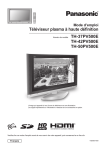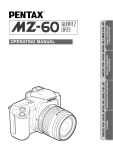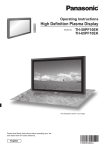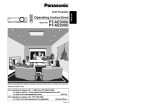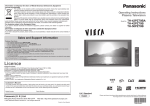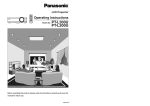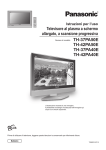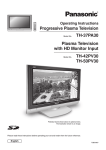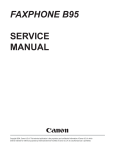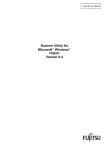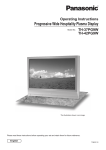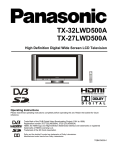Download Panasonic TH-50PV500A Flat Panel Television User Manual
Transcript
OK 1 4 7 2 5 8 0 3 6 9 TV Operating Instructions Plasma Television with HD Monitor Input Model No. TH-42PV500A TH-50PV500A The illustration shown is an image. Pedestal stand shown above is optional extra. Please read these instructions before operating your set and retain them for future reference. English TQBC2051-1 Welcome Dear Panasonic Customer, Welcome to the Panasonic family of customers. We hope that you will have many years of enjoyment from your new Plasma TV. To obtain maximum benefit from your set, please read these Instructions before making any adjustments, and retain them for future reference. Retain your purchase receipt also, and note down the model number and serial number of your set in the space provided on the rear cover of these instructions. Contents Important Safety Notice .............................................. 3 Safety Precautions ..................................................... 4 Maintenance ............................................................... 5 Accessories ................................................................ 6 Fitting remote control batteries ................................... 6 Cable binding instructions .......................................... 7 How to open the front cover ....................................... 7 Antenna connection .................................................... 8 Power On / Off ............................................................ 8 Connections ............................................................... 9 How to connect the Headphones / AV3 S Video Input terminals ................................................... 9 How to connect the Monitor Output terminals to other Equipment .......................................... 10 How to connect the AV1 S Video Input terminals .. 10 How to connect the AV2 / AV4 Component Input terminals ................................................. 11 How to connect the HDMI Input terminal ............... 11 How to connect the PC Input terminal ................... 12 Basic controls: front panel and remote control ......... 13 Using the On Screen Displays ................................. 14 Tuning ....................................................................... 15 Tuning menu.......................................................... 15 Auto tuning ............................................................ 16 Auto tuning (via front panel) .................................. 16 Manual tuning ........................................................ 17 Manual tuning (via front panel) .............................. 17 Channel Allocation .................................................... 18 Picture menu ............................................................ 19 Sound menu ............................................................. 20 Setup menu .............................................................. 21 Owner ID .................................................................. 22 Aspect Controls ........................................................ 23 Multi window ............................................................. 24 PC mode .................................................................. 25 Card operations ........................................................ 27 Teletext operation ..................................................... 35 Still ............................................................................ 37 Stereo / Bilingual Sound Selection ........................... 38 Remote control setting ............................................. 38 VCR / DVD operation ............................................... 39 Troubleshooting ........................................................ 40 Input signal that can be displayed ............................ 41 Specifications ........................................................... 42 WARRANTY ............................................................. 43 This product incorporates copyright protection technology that is protected by U.S. patents and other intellectual property rights. Use of this copyright protection technology must be authorized by Macrovision Corporation, and is intended for home and other limited viewing uses only unless otherwise authorized by Macrovision Corporation. Reverse engineering or disassembly is prohibited. U. S. patent No. 4,907,093. 2 Important Safety Notice WARNING 1) To prevent damage which may result in fire or shock hazard, do not expose this appliance to dripping or splashing. Do not place containers with water (flower vase, cups, cosmetics, etc.) above the set. (including on shelves above, etc.) No naked flame sources, such as lighted candles, should be placed on / above the set. 2) To prevent electric shock, do not remove cover. No user serviceable parts inside. Refer servicing to qualified service personnel. 3) Do not remove the earthing pin on the power plug. This apparatus is equipped with a three pin earthing-type power plug. This plug will only fit an earthing-type power outlet. This is a safety feature. If you are unable to insert the plug into the outlet, contact an electrician. Do not defeat the purpose of the earthing plug. CAUTION 1) This appliance is intended for use in environments which are relatively free of electromagnetic fields. Using this appliance near sources of strong electromagnetic fields or where electrical noise may overlap with the input signals could cause the picture and sound to wobble or cause interference such as noise to appear. To avoid the possibility of harm to this appliance, keep it away from sources of strong electromagnetic fields. 2) If a static electricity discharge occurs inside the front cover, the screen may momentarily flicker. This is not a malfunction. The screen will return to normality in a short while. To prevent electric shock, ensure the grounding pin on the AC cord power plug is securely connected. Trademark Credits • VGA is a trademark of International Business Machines Corporation. • Macintosh is a registered trademark of Apple Computer, USA. • S-VGA is a registered trademark of the Video Electronics Standard Association. Even if no special notation has been made of company or product trademarks, these trademarks have been fully respected. • SD Logo is a trademark. • HDMI, the HDMI Logo and High-Definition Multimedia Interface are trademarks or registered trademarks of HDMI Licensing LLC. CAUTION: Symptoms After-images appear ABCDEF Check Do not allow a still picture to be displayed for an extended period, as this can cause a permanent after-image to remain on the Plasma TV. Examples of still pictures include logos, video games, computer images, teletext and images displayed in 4:3 mode. With no signal present, and without any user operation, the Panasonic screensaver will appear automatically after a few minutes to prevent image retention. Note: The permanent after-image on the Plasma TV resulting from fixed image use is not an operating defect and as such is not covered by the Warranty. This product is not designed to display fixed images for extended periods of time. 3 Safety Precautions WARNING Setup This Plasma TV is for use only with the following optional accessories. Use with any other type of optional accessories may cause instability which could result in the possibility of injury. (All of the following accessories are manufactured by Matsushita Electric Industrial Co., Ltd.) • Pedestal ............................................ TY-ST42PX500 (TH-42PV500A), TY-ST50PX500 (TH-50PV500A) • Display stand .................................... TY-S42PX500W (TH-42PV500A), TY-S50PX500W (TH-50PV500A) • Wall-hanging bracket (vertical).......... TY-WK42PV3W • Wall-hanging bracket (angle) ............ TY-WK42PR2W Always be sure to ask a qualified technician to carry out set-up. Do not place the Plasma TV on sloped or unstable surfaces. • The Plasma TV may fall off or tip over. Do not place any objects on top of the Plasma TV. • If water is spilt onto the Plasma TV or foreign objects get inside it, a short-circuit may occur which could result in fire or electric shock. If any foreign objects get inside the Plasma TV, please consult your local Panasonic dealer. Ventilation should not be impleded by covering the ventilation openings with items such as newspapers, table cloths and curtains. For sufficient ventilation; If using the pedestal (optional accessory), leave a space of at least 10 cm at the top, left and right, at least 6 cm at the bottom, and at least 7 cm at the rear. If using some other setting-up method, leave a space of at least 10 cm at the top, bottom, left and right, and at least 1.9 cm at the rear of the Plasma TV. Electromagnetic interference may occur if electronic equipments are placed near each other. • It will cause interference in image, sound, etc. In particular, keep video equipment away from this product. Keep unneeded small parts and other objects out of the reach of small children. These objects can be accidentally swallowed. Also, be careful about packaging materials and plastic sheets. When using the Plasma TV The Plasma TV is designed to operate on 220 - 240 V AC, 50/60 Hz. Do not cover the ventilation holes. • Doing so may cause the Plasma TV to overheat, which can cause fire or damage to the Plasma TV. Do not insert any foreign objects into the Plasma TV. • Do not insert any metal or flammable objects into the ventilations holes or drop them onto the Plasma TV, as doing so can cause fire or electric shock. Do not remove the cover or modify it in any way. • High voltages which can cause severe electric shocks are present inside the Plasma TV. For any inspection, adjustment and repair work, please contact your local Panasonic dealer. Ensure that the mains plug is easily accessible. Securely insert the power supply plug as far as it will go. • If the plug is not fully inserted, heat may be generated which could cause fire. If the plug is damaged or the wall socket plate is loose, do not use them. Do not handle the power supply plug with wet hands. • Doing so may cause electric shocks. Do not do anything that may damage the power cable. When disconnecting the power cable, pull on the plug body, not the cable. • Do not damage the cable, make any modifications to it, place heavy objects on top of it, heat it, place it near any hot objects, twist it, bend it excessively or pull it. To do so may cause fire and electric shock. If the power cable is damaged, have it repaired at your local Panasonic dealer. If the Plasma TV is not going to be used for any prolonged length of time, unplug the power supply plug from the wall outlet. 4 Safety Precautions If problems occur during use If a problem occurs (such as no picture or no sound), or if smoke or an abnormal odour starts to come out from the Plasma TV, immediately unplug the power supply plug from the wall outlet. • If you continue to use the Plasma TV in this condition, fire or electric shock could result. After checking that the smoke has stopped, contact your local Panasonic dealer so that the necessary repairs can be made. Repairing the Plasma TV yourself is extremely dangerous, and should never be attempted. If water or foreign objects get inside the Plasma TV, if the Plasma TV is dropped, or if the cabinet becomes damages, disconnect the power supply plug immediately. • A short circuit may occur, which could cause fire. Contact your local Panasonic dealer for any repairs that need to be made. CAUTION When using the Plasma TV Do not bring your hands, face or objects close to the ventilation holes of the Plasma TV. • Heated air comes out from the ventilation holes at the top of Plasma TV will be hot. Do not bring your hands or face, or objects which cannot withstand heat, close to this port, otherwise burns or deformation could result. Be sure to disconnect all cables before moving the Plasma TV. • If the Plasma TV is moved while some of the cables are still connected, the cables may become damaged, and fire or electric shock could result. Disconnect the power supply plug from the wall socket as a safety precaution before carrying out any cleaning. • Electric shocks can result if this is not done. Clean the power cable regularly to prevent it becoming dusty. • If dust built up on the power supply plug, the resultant humidity can damage the insulation, which could result in fire. Pull the power supply plug out from the wall outlet and wipe the mains lead with a dry cloth. This Plasma TV radiates infrared rays, therefore it may affect other infrared communication equipment. Install your infrared sensor in a place away from direct or reflected light from your Plasma TV. Maintenance The front of the display panel has been specially treated. Wipe the panel surface gently using only a cleaning cloth or a soft, lint-free cloth. • If the surface is particularly dirty, wipe with a soft, lint-free cloth which has been soaked in pure water or water to which a small amount of neutral detergent has been added, and then wipe it evenly with a dry cloth of the same type until the surface is dry. • Do not scratch or hit the surface of the panel with fingernails or other hard objects, otherwise the surface may become damaged. Furthermore, avoid contact with volatile substances such as insect sprays, solvents and thinner, otherwise the quality of the surface may be adversely affected. If the cabinet becomes dirty, wipe it with a soft, dry cloth. • If the cabinet is particularly dirty, soak the cloth in water to which a small amount of neutral detergent has been added and then wring the cloth dry. Use this cloth to wipe the cabinet, and then wipe it dry with a dry cloth. • Do not allow any detergent to come into direct contact with the surface of the Plasma TV. If water droplets get inside the unit, operating problems may result. • Avoid contact with volatile substances such as insect sprays, solvents and thinner, otherwise the quality of the cabinet surface may be adversely affected or the coating may peel off. Furthermore, do not leave it for long periods in contact with articles made from rubber or PVC. 5 Accessories Check that you have the accessories and items shown Operating Instructions Mains Lead Remote Control Transmitter (N2QAJB000156) Batteries for the Remote Control Transmitter (2 × R6 (AA) size) Clamper × 2 OK 1 4 7 2 5 8 0 3 6 9 TV Fitting remote control batteries 1 2 3 “R6 (AA)” size Pull and hold the hook, then open the battery cover. • • • • Insert batteries - note correct polarity ( + and -). Replace the cover. Make sure that the batteries are fitted the correct way round. Do not mix old batteries with new batteries. Remove old, exhausted batteries immediately. Do not mix different battery types, i.e. Alkaline and Manganese. Do not use rechargeable (Ni-Cad) batteries. 6 Cable binding instructions Cable cover Mains Lead Removal 1. Push down hooks and pull the cover slightly towards yourself to disengage the claws (at 2 points). 2. Slowly pull out in the downward direction. Clamper Open Close Clamp How to fix: Fitting Fix by pushing in till a clicking sound is heard. How to release: Pull down while drawing the knob. 1. Insert the claws (at 2 points) at the bottom end. 2. Push until it clicks. Note: To avoid interference appearing on the screen, do not bundle the RF cable and mains lead together. For using the pedestal Attach the bands. Insert the spigot on the two bands into the pedestal. Connect cables. Example of “connection cable routing” Fastening band Mains Lead Fastening To tighten. Band Clamp Loosening Pull off. Binding strap Keep the knob pressed. Band How to open the front cover Raise the lower part of the door marked “PULL”. 7 Antenna connection For proper reception of VHF / UHF channels, an external antenna is required. For best reception, an outdoor antenna is recommended. VHF Aerial UHF Aerial VCR Mixer ANT OUTPUT ANT INPUT OR 75 Ω Coaxial cable Notes: • Do not put the Coaxial cable close to the mains lead to avoid noise. • Do not place the Coaxial cable under the TV. • Additional equipment, cables and adapter plugs shown are not supplied with this TV set. • To obtain optimum quality picture and sound, an Aerial, the correct cable (75 Ω coaxial) and the correct terminating plug are required. • If a communal Aerial system is used, you may require the correct connection cable and plug between the wall Aerial socket and your TV. • Your local Television Service Centre or Dealer may be able to assist you in obtaining the correct Aerial system for your particular area and the accessories required. • Any matters regarding Aerial installation, upgrading of existing systems or accessories required, and the costs incurred, are the responsibility of you, the Customer. Power On / Off Connect the mains plug to the wall socket. Press the [ ] switch on the TV set to turn the set on. Owner ID setting screen is displayed. See page 22. To switch the TV set to Standby mode, press the button on the remote control. The TV set can be switched on by pressing the button again if it was in Standby mode. OK 1 4 7 2 5 8 0 Note: This TV will still consume some power as long as the mains plug is still inserted into the wall socket. TV Power Indicator Standby : Red On : No Light Remote control signal sensor C.A.T.S. sensor Plasma C.A.T.S. (Contrast Automatic Tracking System) automatically senses the ambient light conditions and adjusts the brightness and gradation accordingly, to optimize contrast. C.A.T.S. is in effect when Menu in Picture menu is set to Auto. See page 19. 8 3 6 9 Connections It is possible to connect a variety of additional equipment to this TV. The following pages detail how to connect external equipment to the front and rear of the TV. Once your equipment is connected, use the following procedure to view the input: TV/AV Press the TV/AV button. Whilst the on screen selector keys are displayed, select the page by pressing the Red or Blue button and then press coloured buttons to select the AV source you wish to view. Red button : AV1 Audio, Video, S Video terminals / Back page Green button : AV2 Audio, Video, Component terminals / AV4 Audio, Video, Component terminals Yellow button : AV3 Audio, Video, S Video terminals / PC terminal Blue button : Next page / HDMI terminal The on screen selector keys will disappear after a few seconds. If you want to select an input when the keys are not shown, press any one of the coloured buttons and the keys will reappear. Notes: • You can also select an AV source using the TV/AV button on the front panel of the TV. Press the TV/AV button repeatedly until you reach the AV source you wish to view. • When a Monaural VCR is used, connect the Monaural Audio cable to the AUDIO L terminal. • Additional equipment and cables shown are not supplied with this TV set. • If the external devices have the aspect adjustment, set to 16:9. OK Red Blue 1 4 7 2 5 8 0 3 6 9 TV AV1 AV1 AV2 AV3 How to connect the Headphones / AV3 S Video Input terminals S VIDEO 4 pin terminal Chrominance in Luminance in Chrominance earth Luminance earth Example of input signal source /MONO VCR AV3 IN (M3 plug) S VIDEO VCR S VIDEO VIDEO AUDIO (Optional) Connect the S VIDEO or VIDEO terminal. DVD PLAYER S VIDEO S VIDEO OUT CAMCORDER VIDEO VIDEO OUT L AUDIO OUT AUDIO R Notes: • The volume level of the headphones can be adjusted by selecting “Headphone volume” from the Sound menu. • Additional equipment and cables shown are not supplied with this TV set. 9 Connections AV IN AUDIO IN L AV1 IN AV2 IN VIDEO Y COMPONENT Y VIDEO MONO R PC AV4 IN COMPONENT S VIDEO MONITOR OUT MONO PB/CB L MONO PB/CB L AUDIO PR/CR PR/CR R R AUDIO How to connect the Monitor Output terminals to other Equipment Example of output signal source VCR MONITOR AV IN AUDIO IN VIDEO IN AV4 IN COMPONENT VIDEO Y COMPONENT Y VIDEO R AUDIO IN AV2 IN L L Amplifier to speaker system AV1 IN S VIDEO MONITOR OUT MONO MONO PB/CB L MONO PB/CB L AUDIO R PR/CR PR/CR R R AUDIO MONITOR OUT How to connect the AV1 S Video Input terminals S VIDEO 4 pin terminal Chrominance in Luminance in Chrominance earth Luminance earth Example of input signal source Connect the S VIDEO or VIDEO terminal. VCR S VIDEO VCR S VIDEO OUT AV IN AUDIO IN DVD PLAYER VIDEO OUT CAMCORDER AV2 IN COMPONENT AV4 IN VIDEO Y Y VIDEO MONO R MONO MONO PB/CB L MONO PB/CB L AUDIO R PR/CR R R AUDIO AV1 IN 10 COMPONENT L L AUDIO OUT AV1 IN S VIDEO MONITOR OUT PR/CR Connections How to connect the AV2 / AV4 Component Input terminals Example of input signal source COMPONENT VIDEO OUT Y DVD PLAYER Y, PB, PR, OUT Connect the VIDEO or COMPONENT VIDEO terminal. PB PR Digital TV-SET-TOP-BOX (DTV-STB) AV IN Y VIDEO OUT AV1 IN AUDIO IN AV2 IN MONO VIDEO COMPONENT Y Y L L AV4 IN COMPONENT S VIDEO MONITOR OUT VIDEO PB/CB R MONO MONO PB/CB MONO L PB/CB L AUDIO OUT R AUDIO PR/CR PR/CR PR/CR R R AUDIO AV2 / 4 IN Note: Component input terminals accept progressive or non-progressive signals format, as well as high definition 720p(50Hz), 720p(60Hz), 1080i(50Hz) and 1080i(60Hz). How to connect the HDMI Input terminal HDMI (High Definition Multi media Interface) is the first all-digital consumer electronics A/V interface that supports uncompressed standard. The HDMI terminal supports both video and audio information. An HDMI-compliant device∗1, such as a Set Top Box or DVD player with HDMI or DVI output terminal can be connected to the HDMI input terminal. • If the external device has DVI output only, use a DVI to HDMI adapter cable∗2 to connect to the HDMI terminal. • Connect the audio cables to the AUDIO IN terminals when using a DVI to HDMI adapter cable. • Select the audio setting in HDMI input. See page 20. Example of input signal source DVD PLAYER AV IN AUDIO IN Digital TV-SET-TOP-BOX (DTV-STB) HDMI OUT AV1 IN AV2 IN COMPONENT S VIDEO MONITOR OUT AV4 IN VIDEO Y L COMPONENT Y VIDEO HDMI IN R MONO MONO PB/CB L MONO PB/CB L AUDIO PR/CR R PR/CR R Notes: • This input terminal is not intended for use with computers. • 720p/1080i signals will be re-formatted to view on your display. • If the external devices have the aspect adjustment, set to 16:9. • For applicable HDMI signals information see page 41. AUDIO Compatible sampling frequency of AUDIO signal through HDMI (L.PCM) : 48 kHz / 44.1 kHz / 32 kHz Notes: • This HDMI connecter is Type A. • If you connect equipment without a digital output terminal, connect to the COMPONENT, S VIDEO or VIDEO input terminal on the TV so you can receive an analogue signal. • The HDMI IN terminal can only be used with 480i, 480p, 576i, 576p, 720p or 1080i picture signals. Set the Digital Set Top Box DIGITAL OUT terminal output setting to 480i, 480p, 576i, 576p, 720p or 1080i. For detailed information, refer to the Digital Set Top Box instruction manual. If you cannot display the picture because your Digital Set Top Box does not have a DIGITAL OUT terminal output setting, use the component input (or the S Video input or Video input). In this case the picture will be displayed as an analogue signal. ∗1. HDMI-compliant device is that has the HDMI Logo on it. ∗2. HDMI-DVI adapter cable: Consult your consumer electronics dealer for availability. 11 Connections How to connect the PC Input terminal Example of input signal source COMPUTER Conversion adapter (if necessary) RGB AV IN AUDIO IN (D-sub 15p) L AUDIO L AV1 IN AV4 IN COMPONENT VIDEO Y COMPONENT Y VIDEO MONO MONO PB/CB R PC L MONO PB/CB L AUDIO (Stereo plug) AV2 IN S VIDEO MONITOR OUT PR/CR R PR/CR R R AUDIO PC IN AUDIO IN Notes: • Connect a cable which matches the audio output terminal on the computer. • Computer signals which can be input are those with a horizontal scanning frequency of 31 to 69 kHz and vertical scanning frequency of 59 to 86 Hz. (However, the image will not be displayed properly if the signals exceed 1,024 lines.) • The display resolution is a maximum of 768 × 768 dots (TH-42PV500A), 1,024 × 768 dots (TH-50PV500A) when the aspect mode is set to “4:3”, and 1,024 × 768 dots (TH-42PV500A), 1,366 × 768 dots (TH-50PV500A) when the aspect mode is set to “16:9”. If the display resolution exceeds these maximums, it may not be possible to show fine detail with sufficient clarity. • Some PC models cannot be connected to the set. • There is no need to use an adapter for computers with DOS/V compatible D-sub 15P terminal. • The computer shown in the illustration is for example purposes only. • Additional equipment and cables shown are not supplied with this set. • Do not set the horizontal and vertical scanning frequencies for PC signals which are above or below the specified frequency range. • For applicable PC signals information see page 41. Signal Names for D-sub 15P Connector 5 4 3 2 1 10 9 8 7 6 15 14 13 12 11 Pin Layout for PC Input Terminal 12 Pin No. Signal Name R Pin No. 6 Signal Name GND (Ground) Pin No. 1 11 Signal Name NC (not connected) 2 G 7 GND (Ground) 12 NC (not connected) 3 B 8 GND (Ground) 13 HD/SYNC 4 NC (not connected) 9 NC (not connected) 14 VD 5 GND (Ground) 10 GND (Ground) 15 NC (not connected) Basic controls: front panel and remote control Headphones jack (see page 9) AV3 terminals (see page 9) PC CARD slot (see page 27) /MONO AV3 IN S VIDEO VIDEO TV/AV button (see page 9) On / Off switch SD CARD slot (see page 27) STR (Normalization store) Used to store tuning and other function settings. Standby On / Off button Switches TV On or Off (Standby mode). Surround On / Off (see page 20) MULTI PIP SD REC MENU button Press to access the Picture, Sound and Setup menus. (see page 14, 19-21) TV/AV N MENU EXIT F.P. Multi Window button (see page 24) Sound mute On / Off SD button Access Card operations. (see page 27-34) OK TEXT Notes: • NTSC-Tint : Receiving NTSC signals. • Tint : Receiving YUV(60Hz) signals. • Tuning mode : Not displayed during AV mode. SD Record button (see page 29) ASPECT SURROUND N (Normalize) button Resets all settings to their default levels. Press to confirm selections and choices. PC CARD EJECT button (see page 27) Increases or decreases the programme position by one. When a function is already displayed, press to increase or decrease the selected function. When in Standby mode, switches TV On. F (Function select) Displays the On Screen Display functions, use repeatedly to select from the available functions - Volume, Contrast, Brightness, Colour, Sharpness, NTSCTint (Tint), Bass, Treble, Balance and Tuning mode. Aspect control button (see page 23) AUDIO INDEX HOLD Switch between viewing TV or AV input. (see page 9) Cursor buttons to make selections and adjustments. Exit the mode. Coloured buttons used for the selection, navigation and operation of various functions. Teletext button (see page 35-37) Text F.P. button (see page 36) Recall Press to display the current system status, for example, Programme number, Channel number, Stereo mode, Aspect mode, Sound menu, Picture menu. 1 4 7 2 5 8 0 3 6 9 Text Hold / Picture Still button (see page 35, 37) Text Index button (see page 37) Direct Programme Number You can select the numbers directly by pressing Programme Number button and the two digit Numbers by pressing “Two Digit” and Programme Number buttons. Programme Number 8 ..... Programme Number 12.... Channel up / down button 8 , 1 , 2 Volume up / down button VCR / DVD buttons (see page 39) Stereo / Bilingual Sound Selection (see page 38) REC VCR DVD 13 Using the On Screen Displays Many features available on this TV can be accessed via the On Screen Display menu system. Use the remote control as shown below to access and adjust features as desired. The MENU button is used to open the main menus and also to return to the previous menu. MENU OK The up and down cursor buttons are used to move the cursor and select menus. 1 4 7 The left and right cursor buttons are used to access menus, adjust levels or to select from a range of options. The OK button is used with a number of features to store settings after adjustments have been made or options have been set. The EXIT button is used to exit the menu system and return to the normal viewing screen. An On Screen Help box is displayed whenever a menu is displayed on the TV. This Help box indicates which buttons on the remote control are used to navigate the menu shown, see above for descriptions of button functions. Note: The Help box is not shown in the menu pictures in this instruction book due to space limitations. 14 2 5 8 0 3 6 9 OK TV EXIT Sound menu Menu Bass Treble Balance Headphone volume Surround Music Off Select Change Exit Return ON SCREEN HELP ‘Instructions’ box Tuning Tuning menu During TV mode MENU Press the MENU button. Move to choose Setup menu. OK Access Setup menu. 1 4 7 Move to choose Tuning menu. Access Tuning menu. 2 5 8 0 3 6 9 Move to choose menu option. Adjust chosen option or access chosen menu. TV Press the EXIT button at any time to go back to watching TV. EXIT Pressing the OK button after having adjusted some features will store the setting as the default (replacing the factory setting). OK Sys select Select the system. (System Selection) NZ/INDONES / Australia SYS SELECT NZ/INDONES Australia Auto tuning REGION Main menu P i c t u r e menu Sound menu New Zealand, Indonesia, etc. Australia Allows you to automatically retune the TV. Useful if you move house and wish to retune your TV to the local stations. See page 16. Manual tuning Allows individual programme positions to be tuned, manually. See page 17. Sound system Allows you to change the sound system used for a programme channel. Choose the required sound system: 5.5MHz / 6.5MHz Setup menu Setup menu Teletext Off timer Ch colour set Child lock Side panel Power save Tuning menu Owner ID TOP Off Off High Off Access Tuning menu Sys select Auto tuning Manual tuning Sound system Colour system Fine tuning Skip Australia 5.5MHz Auto Colour system Lets you select the correct transmission standard for the transmission signal being received. See page 21. Auto / PAL / NTSC 4.43 / NTSC 3.58 Fine tuning Use to make small adjustments to the tuning of an individual station (useful for example when weather conditions are affecting reception quality of a programme). To cancel the Fine tuning, tune again by Manual tuning. Skip It is possible to skip Programme Number on which no TV stations are tuned appearing on the screen. The function is only effective when pressing the Programme Number up or down button either on the TV set or on the remote control. Under the normal viewing, select the Programme Number you would like to skip. Then, access Tuning menu and set Skip to On. Off 15 Tuning Auto tuning Auto tuning automatically retunes your TV. This feature is useful if, e.g., you move house and wish to retune your TV to receive the local stations. Press the MENU button. MENU Move to choose Setup menu. OK Access Setup menu. 1 4 7 Move to choose Tuning menu. 2 5 8 0 3 6 9 Access Tuning menu. Move to choose Auto tuning. TV Notes: • If you proceed with the next step all tuning data will be erased (all stations and their programme positions stored in your TV’s memory will be wiped out so the new settings can be stored). • If you exit the procedure after this point and before Auto tuning is complete, no station information will be stored. Restart and complete the Auto tuning procedure so that the TV is retuned. Access Auto tuning. 12 The TV will search for, locate, store and then sort into order your local stations. AUTO SETUP IN PROGRESS SEARCHING : PLEASE WAIT Once this operation is completed the TV will display the programme now stored on programme position 1. Press the EXIT button at any time to go back to watching TV (please read the Notes in the above procedure). EXIT Exit Return Auto tuning (via front panel) It is also possible to use the control panel buttons on the front of the TV to tune individual programme positions: Press the F button until Tuning mode is reached. Press the –/ or +/ button to access Tuning mode. Press the F button until Auto tuning is reached. Press the –/ or +/ button to start search. Press the TV/AV button at any time to exit the Tuning menu. STR F TV/AV Notes: • If a clear picture with correct colours cannot be obtained when a Broadcast or AV signal is received, refer to the Colour system selection on page 15. • After the Auto tuning is finished, press the Programme Number up button to confirm the tuning condition for each Programme Number. If some Programme Numbers are unused, it is possible to skip such Programme Numbers. Please refer to the Skip function on page 15. 16 Tuning Manual tuning It is possible to retune individual programme positions: Press the MENU button. MENU OK Move to choose Setup menu. Access Setup menu. 1 4 7 2 5 8 0 Move to choose Tuning menu. 3 6 9 Access Tuning menu. Move to choose Manual tuning. TV Access Manual tuning. Select the programme position to be tuned. 1 Press repeatedly until required station is found. When the desired station is found, press the OK button to store. The programme position will flash. Press the EXIT button at any time to go back to watching TV. Manual tuning OK Search down/up Store Exit Return EXIT Programme down/up Manual tuning (via front panel) It is also possible to use the control panel buttons on the front of the TV to tune individual programme positions: Press the F button until Tuning mode is reached. Press the –/ or +/ button to access Tuning mode. Press the F button until Manual tuning is reached. Press the –/ or +/ button to access Manual tuning. Press the TV/AV button to move between Change programme, Search and Change sound system. STR F TV/AV Press the –/ or +/ button to change programme position or start search. When the desired station is found, press the STR button to store. The programme position will flash. Repeat above procedure to tune additional programme positions. 1 5. 5MHz Manual tuning (Front panel) -, + : Search TV / AV : Move cursor STR : To store F : To exit STR F -/ +/ TV / AV Press the F button at any time to exit the Tuning menu. Notes: • If a clear picture cannot be obtained even when a Broadcast or AV signal is received, refer to the Colour system selection on page 15. • After the Manual tuning is finished, press the Programme Number up button to confirm the tuning condition for each Programme Numbers. If some Programme Numbers are unused, it is possible to skip such Programme Numbers. Please refer to the Skip function on page 15. • When using a VCR without video and audio input / output terminals, it is convenient to connect the aerial cable as indicated in the instruction manual of VCR and to set the designated channel to Programme No.“0”. In that case, perform Manual tuning after setting the Colour system and Sound system in advance. Further, in multisystem VCR, it is more convenient to set the designated channel to several Programme Numbers. 17 Channel Allocation Sys select CH DISPLAY 0 1 2 3 4 5 6 7 NZ/INDONES 11 12 13 14 15 16 11 – – – – – – – – 21 19 20 21 22 23 24 Australia RECEIVE CHANNEL – 1 2 – 0 1 2 3 4 5 S2 S10 6 9 9A 10 11 12 S11 28 S44 20 21 57 58 59 62 63 62 63 69 70 73 74 75 76 77 78 79 80 81 69 – – – S’1 S’2 S’3 – – – S1 S2 89 90 91 92 93 94 95 96 97 98 99 100 S10 S11 S12 S13 S14 S15 S16 S17 S18 S19 S20 S21 107 117 118 120 125 18 S41 – – 69 – – – – – – – Picture menu Press the MENU button. MENU Move to choose Picture menu. OK Access Picture menu. 1 4 7 Move to choose menu option. Adjust chosen option or access chosen menu. Press the EXIT button at any time to go back to watching TV. 2 5 8 0 3 6 9 EXIT TV Menu Menu mode will be memorized for each TV, AV1, AV2, AV3, AV4, PC, HDMI and Card operations mode. Dynamic / Standard / Cinema / Auto You can change the level of each Item (Contrast, Brightness, Colour, Sharpness, NTSC-Tint, Colour temperature, Colour management, D.PNR, MPEG NR and 3D-COMB) for each Menu (Dynamic, Standard, Cinema and Auto) according to your personal preference. Contrast, Brightness, Colour, Sharpness Increase or decrease the levels of these options according to your personal preference. Main menu P i c t u r e menu Sound menu Setup menu Picture menu Menu Contrast Brightness Colour Sharpness NTSC-Tint Colour temperature Colour management D. PNR MPEG NR 3D-COMB Dynamic Standard On Auto Off On NTSC-Tint (Tint) The picture hue can be adjusted to suit your taste. Notes: • When the TV is receiving NTSC signals, NTSC-Tint is displayed and level adjustment is possible. • When the TV is receiving YUV (60Hz) or HDMI (60Hz) signals, Tint is displayed and level adjustment is possible. Colour temperature Allows you to set the overall colour tone of the picture. Choose from Cool, Standard and Warm. Colour management Enables vivid colour adjustment automatically. D.PNR Reduces noise in a channel with many noises. Off: Recommended mode when receiving a strong signal. Strong: Applies strong noise reductions regardless of input signals. Weak: Applies weak noise reductions regardless of input signals. Auto: Automatically reduces unwanted picture noise. MPEG NR Reduces MPEG noise. Off / Strong / Mid / Weak This function is effective in reducing the digital block noise when viewing DVD, VCD, SD card or digital broadcasting. The effect will be changed based on the scene and image. MPEG: Compression technology of the image signal adopted by DVD, VCD, SD card or digital broadcasting. 3D-COMB Occasionally, whilst viewing still or slow moving pictures, colour patterning may be seen. Set 3DCOMB to On to display sharper and more accurate colours. Displayed only when receiving PAL or NTSC signals. Not displayed during S Video, Component, PC, HDMI input and Card operations. Note: By pressing the N button on the remote control while the Picture menu is displayed, the selected menu will be changed to the Normal mode. Normalization will not occur if the menu is not displayed when the N button is pressed. The Normal mode is the factory preset condition. Returning to this original condition is called “Normalization”. 19 Sound menu Press the MENU button. MENU Move to choose Sound menu. OK Access Sound menu. 1 4 7 Move to choose menu option. Adjust chosen option or access chosen menu. Press the EXIT button at any time to go back to watching TV. 2 5 8 0 3 6 9 EXIT TV Menu Bass Treble Balance Menu mode will be memorized for each TV, AV1, AV2, AV3, AV4, PC, HDMI and Card operations mode. Music / News / Cinema You can change the level of each Item (Bass and Treble) for each Menu (Music, News and Cinema). Increase or decrease level to enhance or minimise lower, deeper sound output. Increase or decrease level to enhance or minimise sharper, higher sound output. Main menu P i c t u r e menu Sound menu Setup menu Sound menu Menu Bass Treble Balance Headphone volume Surround HDMI input Music Off Auto The levels of sound between the left and right speakers can be adjusted to suit your listening position. Headphone volume Can be adjusted independently of the TV speakers so that everyone can enjoy listening at a level comfortable for them. Surround HDMI input To enjoy a concert hall effect, turn Surround to On. Switching is also possible by pressing the SURROUND button. The benefits of Surround sound are enormous. You can be completely enveloped in sound; just as if you were at a concert hall or cinema. The Surround effect can be obtained without the use of external Surround speakers. Surround On Surround Off Displayed during HDMI input mode. Allows you to choose from Auto, Digital and Analogue. Select to fit the input signal. Auto : Set in normal use Digital : HDMI cable connection Analogue : HDMI-DVI adapter cable connection See page 11. Note: By pressing the N button on the remote control while the Sound menu is displayed, the selected menu (Bass, Treble and Balance) will be changed to the Normal mode. Normalization will not occur if the menu is not displayed when the N button is pressed. The Normal mode is the factory preset condition. Returning to this original condition is called “Normalization”. 20 Setup menu Press the MENU button. MENU Move to choose Setup menu. OK Access Setup menu. 1 4 7 Move to choose menu option. 2 5 8 0 3 6 9 Adjust chosen option or access chosen menu. Press the EXIT button at any time to go back to watching TV. EXIT TV Teletext Allows you to choose 2 modes. See page 35. Not displayed during HDMI, PC mode and 60Hz. TOP / List Off timer Switches the TV off within a preset time which you can choose from between 0 to 90 minutes in 15 minute intervals. Ch colour set Colour density varying between broadcast channels can be adjusted to three levels for each reception channel. Child lock When On, picture and sound of the TV/AV mode being viewed will disappear and a Black screen will appear. Child lock can be set for each programme number and each AV mode. Cannot change the setting during SD Recording. Main menu P i c t u r e menu Sound menu Setup menu Setup menu Colour system Teletext Off timer Ch colour set Child lock Side panel Power save Tuning menu Owner ID Displayed during AV mode. Not displayed during HDMI and AV mode menu PC mode. If a clear picture with current colours cannot be Setup Teletext timer obtained when a Broadcast or AV signal is received, this Off Ch colour set Child lock function is used. Colour system Colour matrix Auto / PAL / NTSC 4.43 / NTSC 3.58 Side panel save PAL and NTSC 3.58 are different colour signal broadcast Power Owner ID transmission systems applicable to differing countries. NTSC 4.43 is a trick playback mode used in special VCR’s to playback NTSC recorded video tapes through PAL television equipment. Colour matrix Displayed during AV mode. Available only with 480p or 576p input signals in a natural colour from digital equipment connected to AV2 / AV4 Component terminals. Select SD or HD to adjust suitable colour parameters for SD (standard definition) or HD (high definition). SD: When the input signal is a normal TV system. HD: When the input signal is a High-Definition system. Side panel Allows you to choose from Off, Low, Mid and High. Do not display a picture in 4:3, 14:9, Picture out of picture, Picture and picture, Picture and text modes for an extended period, as this can cause an after-image to remain on the side panels either side of the display field. To prevent the appearance of such an after-image, illuminate the side panels. TOP Off Off High Off Access Access TOP Off Off Auto SD High Off Access Side panel 4:3 Power save By reducing the brightness of picture, power consumption can be lowered. Tuning menu Provides access to many other features including Sys select and Auto tuning. See page 15. Not displayed during AV mode. Owner ID Allows you to enter a security code and address information. See page 22. 21 Owner ID Owner ID allows you to enter a security code (Owner ID) and personal details into its memory, so that in the unfortunate event of theft it will help the Police to trace the owner. If you wish to check the personal details already entered into the TV (except your PIN number), press the F button (Front panel) and hold for 6 seconds(initially the volume level function will appear, as you continue to hold down the F button it will disappear again, and the Owner ID information will appear). The details already entered are displayed on screen and will disappear after a few seconds. STR F TV/AV If Owner ID information was not entered when you switched on your TV for the first time or it is necessary to alter some of the information, Owner ID can be re-accessed via the Setup menu. MENU Press the MENU button. OK Move to choose Setup menu. Access Setup menu. 1 4 7 Move to choose Owner ID. 2 5 8 0 3 6 9 Access Owner ID. If the Owner ID has previously been set, enter the PIN NUMBER (using 0 to 9 on the remote control) followed by the OK button to proceed, this will take you to the NAME option. 1 4 7 2 5 8 0 3 6 9 If no Owner ID has previously been set, enter the required 4 digit Owner ID PIN NUMBER (using 0 to 9 on the remote control). 1 4 7 2 5 8 0 3 6 9 If a 4 digit PIN NUMBER was entered above, you will be taken automatically to the NAME line. TV OK Setup menu Teletext Off timer Ch colour set Child lock Side panel Power save Tuning menu Owner ID TOP Off Off High Off Access If not, move to the NAME line. Yo u n o w h a v e t h e o p p o r t u n i t y to enter your details and help the police crack crime see instruction book Owner ID Change character. PIN NUMBER NAME HOUSE NO POSTCODE Select character position. ∗∗∗∗ ∗∗∗∗∗∗∗∗∗∗∗∗∗∗ ∗∗∗∗∗∗∗∗∗∗∗ ∗∗∗∗∗∗∗∗∗∗∗ 0123456789 Change character S e l e c t character Store Owner ID Exit Return Repeat above until NAME, HOUSE NUMBER and POSTCODE are entered. Press the OK button to store the details. Press again when you are asked, “Are you sure?”. : : : : OK For future reference, write your PIN NUMBER here : 22 Aspect Controls The Widescreen TV will allow you to enjoy viewing the picture at its optimum size and aspect, including widescreen cinema format pictures. Press the ASPECT button repeatedly to move through the aspect options: ASPECT OK 16:9, 14:9, Just, 4:3, Zoom1, Zoom2 and Zoom3 PC mode: 16:9 and 4:3 OR Press the ASPECT button. Whilst the on screen selector keys are displayed, use the Red or Green buttons to move in either direction through the aspect options. 1 4 7 Red 3 6 9 Green Note: This is not available for 720p and 1080i signals input. Aspect is fixed to 16:9. 16 : 9 2 5 8 0 TV 16 : 9 16:9 will display a true 16:9 (anamorphic) picture with no aspect distortions. Signals in the 4:3 format will be stretched to fit the picture. 16 : 9 14 : 9 14 : 9 14:9 will display a 14:9 picture at its standard 14:9 size without any stretching. 14 : 9 Just Just Use Just when you wish to expand a 4:3 picture to fill the whole screen (rather than watching a programme with black stripes down the left and right sides of the picture). The 4:3 picture will be stretched horizontally so that the image fills the screen, this is done in such a way that the stretching is only obvious at the left and right edges of the screen. 4:3 Just 4:3 4:3 will display a 4:3 picture at its standard 4:3 size with no aspect distortions. 4:3 Zoom1 Zoom1 Zoom1 allows you to magnify the picture. Zoom1 Zoom2 Zoom2 Zoom2 will display 16:9 anamorphic letterbox pictures as a full screen display with no aspect distortions. Zoom2 Zoom3 Zoom3 will display 21:9 letterbox pictures as a full screen display with no aspect distortions. 16:9 will display the picture at its maximum size but with slight stretching. Zoom3 Zoom3 23 Multi window Press the MULTI PIP button. Whilst the on screen selector keys are displayed, use the Red or Green buttons to move between the PIP (Picture in picture), POP (Picture out of picture) and PAP (Picture and picture) feature. Press the Blue button to swap the contents of the two windows. The on screen selector keys that appear for the features clear after a few seconds. If you want to select an operation when the keys are not shown, press the MULTI PIP button again and the keys will reappear. Press the MULTI PIP button (whilst the selector keys are displayed) to return to normal viewing. MULTI PIP OK 1 4 7 TV/AV Notes: • This operation cannot be made during PC, HDMI, Card operations mode and progressive, HD signal input (Y, PB/CB, PR/CR). • This TV has one tuner. When the main and sub windows are both TV mode, these are the same TV channel. Changing the channels 2 5 8 0 3 6 9 TV Picture in picture mode 2 AV1 • Main window Press the Programme Number button on the remote control. • Sub window Press the MULTI PIP button. Whilst the on screen selector keys are displayed, press the Programme Number button on the remote control. POP PAP main window Change A B sub window AV1 2 Changing the mode • Main window Press the TV/AV button to switch between the TV and AV mode. During the AV mode, press any coloured button. Whilst the on screen selector keys are displayed, press coloured button to select the AV source. • Sub window Press the MULTI PIP button. Whilst the on screen selector keys are displayed, press the TV/AV button to switch between the TV channel and all AV sources in turn. POP PAP Change Press the Blue button. Each time the main window and the sub window are swapped. Picture out of picture mode 2 AV1 PAP PIP Change Picture and picture mode 2 AV1 PIP 24 POP Change PC mode When you switch to PC input, the menu will be changed. About the PC connection, see page 12. TV/AV Press the TV/AV button. Whilst the on screen selector keys are displayed, press the Blue button to move to the next page, and then press the Yellow button to access PC mode. OK Yellow Blue 1 4 7 Press the TV/AV button again to go back to watching TV. 2 5 8 0 3 6 9 Picture menu During PC mode MENU Press the MENU button. Main menu P i c t u r e menu Move to choose Picture menu. Sound menu Access Picture menu. Setup menu Move to choose menu option. Picture menu Adjust chosen option or access chosen menu. Press the EXIT button at any time to exit Picture menu. EXIT Menu Contrast Brightness Sharpness Colour temperature Advanced setting Dynamic Standard Access Advanced setting Menu, Contrast, Brightness, Sharpness, Colour temperature About settings, see page 19. Advanced setting Access to adjust to the fine picture at a professional level. W/B High R : Adjusts the white balance for light red areas. W/B High B : Adjusts the white balance for light blue areas. W/B Low R : Adjusts the white balance for dark red areas. W/B Low B : Adjusts the white balance for dark blue areas. Gamma : 2.0 2.2 2.5 S Curve W / B High W / B High W / B Low W / B Low Gamma R B R B 2.2 Note: Carry out “W/B” adjustment as follows. 1. Adjust the white balance of the bright sections using the “W/B High R” and “W/B High B” settings. 2. Adjust the white balance of the dark sections using the “W/B Low R” and “W/B Low B” settings. 3. Repeat steps 1 and 2 to adjust. Steps 1 and 2 affect each other’s settings, so repeat each step in turn to make the adjustment. Sound menu During PC mode Press the MENU button. MENU Move to choose Sound menu. Main menu P i c t u r e menu Sound menu Access Sound menu. Setup menu Move to choose menu option. Sound menu Adjust chosen option or access chosen menu. Press the EXIT button at any time to exit Sound menu. EXIT Menu Bass Treble Balance Headphone volume Surround Music Off Menu, Bass, Treble, Balance, Headphone volume, Surround About settings, see page 20. 25 PC mode Setup menu During PC mode Press the MENU button. MENU Main menu P i c t u r e menu Move to choose Setup menu. Sound menu Access Setup menu. Setup menu Move to choose menu option. Setup menu PC setup Side panel Power save Adjust chosen option or access chosen menu. Press the EXIT button at any time to exit Setup menu. PC setup EXIT PC setup Input resolution Clock H-pos V-pos Clock phase Sync VGA H&V Access to adjust chosen option. Input resolution : Displayed during VGA(640 × 480 dots), WVGA(852 × 480 dots), XGA(1,024 × 768 dots), WXGA(1,366 × 768 dots) input signals. Select WVGA or WXGA during WVGA or WXGA input signal to avoid noise. Clock : If a periodic striped pattern (noise) occurs, carry out adjustments to reduce the noise to the lowest level. H-pos : Adjust the horizontal position. V-pos : Adjust the vertical position. Clock phase : Eliminate the flickering and distortion. Carry out this adjustment after adjusting Clock. Adjust to reduce noise to the most inconspicuous level. Sync : H & V - To synchronize by the horizontal and vertical signals from your PC. On G - To synchronize by the green signal form your PC (if available). Side panel, Power save About settings, see page 21. H-freq. / V-freq. If the input signal is not applicable, the characters will turn to red. For applicable PC signals information see page 41. 26 Access Off Off Card operations This function lets you display Still images (JPEG) or Moving pictures (MPEG4) recorded by this unit, DIGA, D-snap or digital camera on a memory card when it is inserted in the proper card slot. Inserting and removing a card Compatible card type and maximum card size SD CARD slot • SD Card (1GB) • miniSD Card∗ (512MB) • Multi Media Card (128MB) PC CARD slot • SD Card (1GB) • miniSD Card∗ (512MB) • Multi Media Card (128MB) • Compact Flash (1GB) • Smart Media (128MB) • Memory Stick (128MB) • xD Picture Card (512MB) • Flash ATA (128MB) • Memory Stick Pro (1GB) The cards require standard PC card adapter. (Some PC card adapter will not be compatible.) SD CARD slot Insertion ∗ miniSD Card requires miniSD™ adapter. Label-side upward Insert until it has clicked in. Removal Push the center of the card. PC CARD slot Turn the TV off before inserting or removing a PC card. Holding both edges, Insertion securely insert it to the depth. Terminal face to the depth. Align the direction of mark. Label-side upward Removal 1. Push the EJECT button pops out. 2. Push it again. If the EJECT button does not pop out Push in PC card again, and then push again the EJECT button. Note: If the card adapter is used, remove it together with the adapter. • This function is not compatible with card type hard disk (Micro Drive, Mobile type hard disk, etc). • Memory cards are not supplied with this television. • When both SD card and PC card are inserted in the slot, SD card has the priority. You can change the priority. See page 32. Note: Suitable SD Memory Cards Please confirm the latest information on the following website. http://panasonic.co.jp/pavc/global/cs (This site is in English only) Card Data Protection • Do not remove the card or turn the unit off while the unit is accessing the information. Such action may damage the memory card or the unit itself. • The blue LED lights during recording. • Before inserting or removing the PC card, make sure that the TV is turned Off. Otherwise, it may damage the unit. • Do not touch the terminals on the back of the SD card/PC card. • Always insert a card in the correct direction. Failure to do so may result in damage to the card and this unit. • Do not subject the card to excessive pressure or strong impacts. • Electrical interference, electrostatic discharges and malfunctions of the unit or card may all result in data loss or damage to the card. • Stored data should be periodically backed up as a protection against data corruption, data loss or device malfunction. Please note that our company shall not accept any liability for damage or loss of stored data. WARNING: As with an small object, SD card can be swallowed by young children. Do not allow children to handle SD card. Please remove SD card immediately after use. 27 Card operations Folders and Files • Photo view can show still images recorded by a digital still camera with DCF∗ and EXIF standard JPEG file. ∗ DCF (Design rule for Camera File system) Unified standard established by Japan Electronics and Information Technology Industries Association (JEITA). If the image is imported from a PC, it must follow the EXIF (Exchangeable image file format) 2.0, 2.1, 2.2 or JFIF (JPEG file interchange format) in addition to the DCF (design rule for Camera File system) format. • MPEG4 view can only show moving pictures recorded by this unit, Panasonic DVD recorder DIGA or mobile camera D-snap. • When recording in MPEG4, format the SD card with this unit. The card may not operate properly if formatted with different equipment. • Memory cards must be formatted with FAT12 or FAT16 in order to be viewed on TV. If the card is not formatted, it may cause incompatibility with certain memory card adapters. If this happens, reformat the card using your digital camera. Reformatting the card will erase the images and pictures stored in it. Refer to your camera manual for more information. • Maximum number of files that can be displayed: 65,535. • Picture resolution: Compatible in the range 8 x 8 - 5,120 x 3,840 If the picture resolution is not compatible, the image will be shown as the error display. • The JPEG modified using a PC may not be displayed on TV. • This function cannot display Motion JPEG and still image not DCF formatted (i.e. TIFF, BMP). • If the file is partially corrupted, it may be shown in lower resolution. • The displayed image size depends on the recorded image size. • The number of pixels for movies is 320 x 240 (QVGA) or 176 x 144 (QCIF). • When the number of files exceeds 65,535, no further recording is possible. • The audio format used is G.726 (32 Kbps, 8 kHz sampling frequency, monaural). Example folder structure When the Card file hierarchy is displayed on the PC as shown below. ROOT DCIM 100_PANA Folder names consist of a 3-digit folder number which is followed by five arbitrary characters. P1000001.JPG P1000002.JPG P1000003.JPG P1000004.JPG File names consist of four arbitrary characters followed by a 4-digit file number. (Use the characters “a-z”, “A-Z”, “0-9” and “_” to name a directory or a file.) SD_VIDEO Created automatically PRL001 MOL001.ASF MOL002.ASF MOL003.ASF MOL004.ASF Folder names consist of “PRL” followed by three characters. File name consist of “MOL” followed by three characters. (Use the three characters “a-f”, “A-F” and “0-9” to name a directory or a file.) Notes: • Folder and file names may vary according to the digital camera. • Do not use two-byte characters or other special codes. • The card may become unusable with this unit if file or folder names are changed. 28 Card operations SD Record The TV channels can be recorded on the SD card. The recording is not available for AV input signal. During recording, it is possible to watch other terminals input signal. Setup Rec mode and Rec time in Setup menu before recording. See page 33. Select the channel you want to record. OK 1 4 7 2 5 8 0 3 6 9 Insert the SD card into the card slot. See page 27. SD REC Press the SD REC button to start recording. If the remaining time is not enough or Rec time in Setup menu is set to No setting, the message will appear. Remaining time is not enough TV Rec time is set to No setting Start recording? Start recording? Not enough memory Current setting Rec time 180min Rec mode Economy Recordable at 15min Current setting Rec time No setting Rec mode Economy Recordable at 17min Press the OK button to start recording. Press the EXIT button to cancel. Notes: • You cannot record the copy protected signals. • Even if the Off timer function is activated or the [ ] button is pressed during recording, the recording will not stop. • Do not press the [ ] switch on the TV during recording. Otherwise the file will be broken. • Do not remove the SD card while recording. The data being recorded and other data stored on the SD card may become unreadable. • SD recording may not be fully compatible or playable in some PC software or PDA devices. • When two pictures are shown on the same screen as Multi window functions, the main window is the one that is recorded. The picture can be switched for the sub window. • If the signal system is changed during recording, it cannot be recorded completely. • The signals without video (only audio) cannot be recorded completely. To cancel the recording SD REC Press the SD REC button during recording. The confirmation message will appear. During the message appears, press the OK button. OK Recordable time for SD card Size 64MB Extra fine (Time is approximate) Super fine Fine Normal Economy 7minutes 9minutes 23minutes 34minutes 1hour 21minutes 128MB 14minutes 18minutes 44minutes 1hour 6minutes 2hours 35minutes 256MB 28minutes 37minutes 1hour 32minutes 2hours 17minutes 5hours 20minutes 512MB 55minutes 1hour 10minutes 3hours 4hours 30minutes 10hours 40minutes 1hour 50minutes 2hours 20minutes 6hours 9hours 21hours 20minutes 1GB This product is licensed under the MPEG-4 patent portfolio license for the personal and non-commercial use of a consumer to (i) encode video in compliance with the MPEG-4 Video Standard (“MPEG-4 Video”) and/or (ii) decode MPEG-4 Video that was encoded by a consumer engaged in a personal and non-commercial activity and/or was obtained from a licensed video provider. No license is granted or implied for any other use. Additional information may be obtained from MPEG LA. See http://www.mpegla.com. 29 Card operations Basic operation To enter Card operations mode OK Press the SD button. To return to the SD card menu 1 4 7 EXIT Press the EXIT button. 2 5 8 0 3 6 9 To exit Card operation SD card During the SD card menu is displayed, press the SD button to return to normal picture. MPEG4 view Photo view Setup Memory left MPEG4 view The moving pictures recorded by this unit, DIGA or D-snap will be played back. This function is supported by SD cards only. Press the SD button. SD card MPEG4 view Move to choose MPEG4 view. Photo view Access MPEG4 view. The thumbnail screen is displayed. Setup Select the file. Press the OK button. The moving picture starts. Notes: • Picture menu, Sound menu (in playback only) or Card setup menu (in thumbnail only) adjustment is possible by pressing the MENU button during MPEG4 view. • “Date” shows the date on which the recording was made by this unit, DIGA or D-snap. Its format is 01/01/2000 when recordings are made without date signal. Memory left OK Error display (images that could not be loaded, etc.) Selected File 00001/00028 MPEG4 VIEW MODE Select Play Select Exit SD : Return Lock Delete Filename Date : : MOL001 01/01/2000 Inserted card displayed (this does not appear for PC cards) Movie without sound Movie for which lock has been set 30 Card operations During the playback When the operation guide is not displayed, press the (Recall) button to display it. During the operation guide is displayed ( ) Press to pause. ( ) Press to playback. OK ( ( , ) Press to skip the picture. Press and hold to Rew/FF. ) Press to stop. Notes: • During the playback, the volume can be adjusted using the Volume up/down button. • During the playback, no signals are output from the monitor output terminals. • During the playback, the Aspect ratio can be changed by pressing the ASPECT button. Lock / Unlock the file Select the file you want to lock in the thumbnail. Press the Blue button to lock the file. Blue Press again to unlock. Delete the file Select the file you want to delete in the thumbnail. Press the Red button to delete the file. Press again to confirm your decision. Red Note: If the file is locked, it is not possible to delete. Card setup menu Press the MENU button during MPEG4 view (thumbnail). Move to choose Card setup menu. MENU Main menu P i c t u r e menu Sound menu Access Card setup menu. Card setup menu Move and adjust options. Frame size (Normal or Large) Select the Frame size of the playback picture. Card setup menu Frame size Repeat Normal Off Repeat (Off, One file or All) Select the repeat mode. 31 Card operations Photo view The still images recorded by the digital camera will be displayed. This function supports both SD cards and PC cards. Press the SD button. SD card MPEG4 view Move to choose Photo view. Photo view Access Photo view. The thumbnail screen is displayed. Setup Select the file. Memory left Press the OK button to view. OK Notes: • Picture menu or Card setup menu adjustment is possible by pressing the MENU button during Photo view. • During single view and Slide show, the Aspect ratio can be changed by pressing the ASPECT button. 00001/00028 PHOTO VIEW MODE Select View Select Exit SD : Return During single view When the operation guide is not displayed, press the to display it. (Recall) button During the operation guide is displayed Filename Date Pixel : : : 800-0003 06/12/2003 2048x1536 Inserted card displayed Press to skip the previous view. Press to display the thumbnail. OK Press to rotate the view. Each press rotates the view ninety degrees. Press to skip the next view. Press the Red button to zoom the view. During zoom mode, you can move the position by using the cursor buttons. Card setup menu Red MENU Press the MENU button during Photo view. Card setup menu Move to choose Card setup menu. Slide show Interval Repeat Card Access Card setup menu. Move and adjust options or access Slide show. Slide show Select the settings of Interval and Repeat before accessing Slide show. Interval (5sec, 10sec, 15sec, 30sec, 60sec, 90sec or 120sec) Select the length of time that a slide is being displayed on screen. Repeat (On or Off) Select the repeat on or off. Card (SD or PC) Select either SD or PC when both cards are inserted in the slots. Not selected when one card is inserted. 32 Access 5sec Off SD Card operations Setup Press the SD button. SD card MPEG4 view Move to choose Setup. Photo view Access Setup. Setup Move to choose menu option. Memory left Adjust chosen option or access chosen menu. Setup Economy No setting Access Rec mode Rec time Card format Rec mode (Extra fine, Super fine, Fine, Normal or Economy) The quality of picture can be changed. The recordable time will be changed by Rec mode. Notes: • Multi Media Cards do not support the Extra fine and Super fine recording mode. If the recording is started in these status, recording will automatically be performed in the Fine mode. • The quality of audio is not changed. Rec time (No setting, 5min, 10min, 15min, 30min, 60min, 90min, 120min or 180min) Set the recording time before recording. Note: If you set Rec time to No setting, the recording does not stop until the card is fully recorded. Card format You can format the card. Notes: • If the card is formated, all data is erased. • Only cards that are supported by the SD card slot can be formatted. • Do not remove the SD card while formatting. That may cause the card to not be able to record properly. Memory left You can confirm the remaining time for recording in each Rec mode. SD card Press the SD button. MPEG4 view Photo view Move to choose Memory left. Setup Access Memory left. The recordable time informations are displayed by each Rec mode. Note: Since Multi Media Cards do not support the Extra fine and Super fine recording mode, “----” appears. Memory left Memory left 12MB Recordable time Economy Normal Fine Super fine Extra fine 15min 5min 3min 1min 1min Less than (Time is approximate) 33 Card operations Error messages Is SD Card in? Insert a card. SD Card is locked Please unlock to operate Unlock the SD card. This file is locked Please unlock to operate Unlock the file in the card. This type of format is not supported The card must be formatted with FAT 12 or FAT 16. Still image must be with DCF and EXIF standard JPEG file. Moving picture must be with MPEG4 standard ASF file. This type of card is not supported Incompatible card is inserted. Broken file Cannot display image The file is broken. Memory full The card memory is full. Not enough memory The card does not have enough memory to operate. Cannot read file The file is not readable. Unrecordable source SD recording is stopped It is not possible on restricted channels. Error Check card Re-insert the card. If the error persists, format the card. Card recording in progress Please stop recording to operate The tuning buttons for the main picture do not work while recording is in progress. 34 Teletext operation • Teletext features may vary depending on the Broadcasting Companies and is only available if the channel selected is transmitting Teletext. • Pressing the MENU button whilst in Teletext operation will display the contrast function with a cyan bar, press the left and right cursor buttons to alter the setting as required. • Pressing the MENU button whilst in Teletext operation will display special function options at the bottom of the screen. • Pressing the Volume up / down button whilst in Teletext operation will display the volume function with a green bar, press the Volume up / down button to alter the setting as required. What is List mode? In List mode, four differently coloured page numbers are situated at the bottom of the screen. Each of these numbers can be altered and stored in the TV’s memory. What is TOP mode? In TOP mode, four differently coloured subjects are situated at the bottom of the display. To access more information about one of these subjects, press the appropriately coloured button. This facility enables fast access to information on the subjects shown. TV / Teletext mode Press the TEXT button to switch between the current programme and teletext. TEXT 1 4 7 2 5 8 0 3 6 9 MENU Green MENU Red Page Selection Pages can be selected in two ways: a. Press the Up / Down cursor buttons to increase or decrease the page number by one. b. By entering the page number, using 0 - 9 on the remote control. Full / Top / Bottom Press the MENU button to display special functions, followed by the Green button. Press the Green button again to expand the BOTTOM half. Press again to return to normal (FULL) size. Reveal Press the MENU button to display special functions, followed by the Red button to reveal hidden words e.g., quiz page answers. Press again to hide. Red / Green / Yellow / Blue buttons In TOP mode they correspond to the differently coloured subjects. In List mode they correspond to the differently coloured page numbers. 1 4 7 2 5 8 0 3 6 9 HOLD OK List Store In List mode the four page numbers can be altered (programme positions 1 - 25 only). To do this, press one of the four coloured buttons and enter the new page number. Press and hold the OK button, the page numbers will change to white indicating that the page is stored. HOLD To hold the Teletext page when viewing multi-page information. Press again to return to automatic page update. 35 Teletext operation It is not possible to change the programme position when in News flash, Update or Sub Coded Page Access operation. 1 4 7 Blue 2 5 8 0 3 6 9 OK F.P. MENU Yellow Favourite Page (F.P.) Stores a favourite page in memory for instant recall. To store such a page, the TV must be in List mode, and the programme position must be from 1 - 25. Press the Blue button, select the page number, then press and hold the OK button. The page number is now stored. Press the F.P. button to recall this page. Update Display Press the MENU button to display special functions, followed by the Yellow button to view the TV picture whilst searching for a Teletext page (this is not necessary in Picture and text mode, as the picture is displayed on the left of the screen). When found, the screen will display the page number at the top left. Press the Yellow button to view the page. Press the TEXT button again to return to normal TV operation. News Flash When a news flash page has been selected, press the MENU, Yellow buttons, to view the TV picture. When an update is received, the page number will be displayed on screen. Press the Yellow button to display the News Flash. Press the TEXT button to return to normal TV operation. Update Press the MENU, Yellow buttons to see the update of information on certain pages. When an update is received, the page number will be displayed at the top left of the screen. Press the Yellow button to view the page. Press the TEXT button to return to normal TV operation. Accessing sub pages When Teletext information exceeds one page, it may take some time for the automatic changing of the sub pages to reach the sub page you require. As each sub page is found its number is displayed at the top of the page so that you may select it; as more sub pages are picked up, the display at the top of the page changes, so that you are always offered the most recently transmitted selection of sub pages. In Teletext operation, use the following procedure to access sub pages: 1 4 7 2 5 8 0 3 6 9 If the sub page you want to look at is not yet available, press the MENU button (to display special functions) followed by the Yellow button to view the TV picture whilst waiting for more sub pages to be found. The sub pages found will be displayed across the top of the screen. MENU Yellow 36 When the sub page you are waiting for is available press the Yellow button to return to viewing the Teletext pages, then use the left and right cursor buttons to select the sub page of your choice. The maximum number for sub page that can be entered is restricted to 79 by broadcasters. Notes: • If you do not want to display the on screen selector keys on the TV picture whilst waiting for a sub page to be found, press the MENU button to clear the keys from the screen. Press again to redisplay the keys. • If you have cleared the special function keys from the screen and then used the left and right cursor buttons to select a sub page, whilst still viewing the TV picture, you must press the MENU button then the Yellow button to display the Teletext page again. • If the top of the page indicates that sub pages are being transmitted but the page displayed never changes, then the ‘sub page number’ is there to show the page contents have been updated, there are no sub pages. Teletext operation MENU Blue Alternatively, if you know which sub page you require, press the MENU button (to display special functions) followed by the Blue button; T**** will be displayed where the page number is normally found. Enter desired sub page number before the T**** disappears. e.g., to select page 6 enter 0, 0, 0 and 6. Press the Yellow button to view the TV picture whilst waiting for more sub pages to be found. The sub pages found will be displayed across the top of the screen. When the page is available, press the Yellow button to view the page. Regardless of how many pages are found, pressing the Yellow button will take you to the sub page which you requested. Press the TEXT button to return to normal TV operation. INDEX When in TOP operation Press the INDEX button to return to the main index page. Depending on the way information is transmitted, this may have to be pressed more than once to return to the main index page. INDEX TEXT MULTI PIP Picture and text Press the TEXT button, followed by the MULTI PIP button to move between viewing teletext and the Picture and text mode. Picture and text mode lets you see the current programme and a page of teletext side by side. Whilst using this feature, the remote control affects the teletext page; if you wish to make changes to the programme viewed press the TEXT button to return to watching the programme on its own then make the desired changes. Still Press the HOLD button to freeze the picture. Press again to return to watching the current programme. HOLD OK Note: This function is not available in MPEG4 view, Photo view and PC mode. 1 4 7 2 5 8 0 3 6 9 TV 37 Stereo / Bilingual Sound Selection When you receive the stereo / bilingual sound system, sound output modes can be selected by pressing the Stereo / Bilingual Sound Selection button. Audio Signal Mode Indicator STEREO MAIN I SUB II I II MONO NICAM .......Used in New Zealand, Singapore, Hong Kong etc. Type of broadcast Mode Indicator Regular broadcast (Standard Audio) No Indicator Regular + NICAM MONO I (MAIN I ) NICAM STEREO II I I A2(German) .......Used in Australia, Malaysia etc. Regular broadcast BILINGUAL or DUAL MONO: Type of broadcast (Standard Audio) MAIN I / SUB II I II Mode Indicator No Indicator NICAM DUAL MONO (MAIN I / SUB II ) STEREO Notes: • If the stereo signal is poor or the receiving conditions are not optimum or if STEREO:MONO automatic switching occurs, it is recommended you switch from STEREO to MONO. • Even when the contents of the receiving signal undergo changes, selection mode is kept intact. • When the receiving conditions deteriorate, listening will be easier if the mode is set to the MONO position, using the stereo / bilingual sound selection button. • DUAL, also known as DUAL MONO or as BILINGUAL is not currently transmitted in some countries. Remote control setting Remote Control Operation is possible for the Panasonic VCR’s and DVD’s equipment. After completion of setting, execute the various operations after pressing the VCR / DVD selection switch. VCR Switch to select VCR or DVD. DVD While pressing the VCR / DVD Power button, press the manufacturer code (enter the two digit code), and press the VCR / DVD Stop button. 1 4 7 VCR Manufacturer Panasonic/ National OK Code 10,11,12,13 2 5 8 0 3 6 9 1 4 7 2 5 8 0 DVD Manufacturer Panasonic Code 70, 71 Notes: • After setting, execute operation confirmation. If there is no operation, set a different code. • The respective VCR / DVD code is cancelled when battery has been exchanged. Please set it again. • Depending on the model, operation may not be possible. • In some cases, new products may not be operative. 38 3 6 9 VCR / DVD operation The Remote Control is capable of operating some functions of selected Panasonic VCRs and DVD (Digital Versatile Disc) equipment. Some VCR and DVD equipment have different functions, so to ensure compatibility please refer to the equipment’s instruction book or consult your dealer for details. MULTI PIP SD REC VCR DVD ASPECT SURROUND TV/AV N Standby Press to switch the VCR, DVD or DVD recorder to Standby mode. Press again to switch back on. OK MENU VCR / DVD switch Use this switch to select whether controls operate the DVD equipment or VCR. EXIT Play Press to playback the tape or DVD. TEXT 1 4 7 F.P. INDEX HOLD 2 5 8 0 Stop Press to stop the tape or DVD. 3 6 9 Skip / Fast Forward / Cue VCR: Press to fast forward the tape. In Play mode, press to view the picture rapidly forward (Cue). When fast forwarding the tape, the picture noise may occur. DVD: Press to skip to the next track or title. Press and hold to search forward. Skip / Rewind / Review VCR: Press to rewind the tape. In Play mode, press to view the picture rapidly in reverse (Review). DVD: Press to skip to the previous track or title. Press and hold to search backward. REC VCR DVD Pause / Still Press in Play mode, the picture will pause. Press again to restart play. DVD: Press and hold for slow-motion play. Programme Up / Down Press to increase or decrease the programme position by one. REC Record Press this button to start recording. 39 Troubleshooting If there is a problem with your TV, please refer to the table below to determine the symptoms, then carry out the suggested check. If this does not solve the problem, please contact your local Panasonic dealer, quoting the model number and serial number (both found on the rear of the TV). Symptoms Picture Checks Sound Aerial location, direction or connection Snowy Picture Noisy Sound Aerial location, direction or connection Multiple Images Normal Sound Electrical appliances Cars / Motorcycles Fluorescent lights Interference Noisy Sound Switch on D.PNR in Picture menu to reduce picture noise. Volume level Sound mute switched on. Normal Picture No Picture No Sound No Sound TV set to AV mode. Not plugged into AC outlet. Not switched on. Picture / Sound controls set at minimum levels. Check if in Standby mode. Colour controls set at minimum levels. Colour System No Colour Normal Sound Retune Channel (s). Poor or Distorted Picture Weak or No Sound Sound reception may have deteriorated. Sound System Normal Picture Weak or Distorted Sound HDMI cable is not connected securely. Turn the power supply of the TV and connected equipment off then Poor Video. turn on. (Snow noise, no picture, picture runs, etc.) H Check compatibility of input signal from the connected equipment. D The connected equipment must be EIA/CEA-861/861B compliant. M Change the audio setting of the connected equipment to L.PCM. I Check the setting of HDMI input in Sound menu. Poor Audio. If the problem is due to the digital audio connection, change to the analogue audio connection. The error message appears. Please consult an Authorized Service Center. The SD card cannot be used even when it is formatted. Please consult an Authorized Service Center. 40 Troubleshooting CAUTION: Symptoms Some parts of the screen do not light up. After-images appear ABCDEF Check The plasma TV panel is manufactured using an extremely high level of precision technology, however, sometimes some parts of the screen may be missing picture elements or have luminous spots. This is not a malfunction. Do not allow a still picture to be displayed for an extended period, as this can cause a permanent after-image to remain on the Plasma TV. Examples of still pictures include logos, video games, computer images, teletext and images displayed in 4:3 mode. With no signal present, and without any user operation, the Panasonic screensaver will appear automatically after a few minutes to prevent image retention. Note: The permanent after-image on the Plasma TV resulting from fixed image use is not an operating defect and as such is not covered by the Warranty. This product is not designed to display fixed images for extended periods of time. Sleep Feature If the set is not switched off when the TV station stops transmitting, it will automatically go to standby mode after 30 minutes. This function will not operate when this TV is in AV mode. Notes: • External surfaces of the unit may become hot during operation. But this is completely normal. • See label on the base of this equipment for ratings and other information. Input signal that can be displayed Applicable input signal for Component (Y, PB/CB, PR/CR), HDMI and PC (D-sub 15P) (∗ Mark) Signal name 480i (60 Hz) 480p (60 Hz) 576i (50 Hz) 576p (50 Hz) 720p (50 Hz) 720p (60 Hz) 1,080i (50 Hz) 1,080i (50 Hz)*1 1,080i (60 Hz) 640 × 400 @70 Hz 640 × 480 @60 Hz 640 × 480 @75 Hz 800 × 600 @60 Hz 800 × 600 @75 Hz 800 × 600 @85 Hz 1,024 × 768 @60 Hz 1,024 × 768 @70 Hz 1,024 × 768 @75 Hz 1,024 × 768 @85 Hz 1,280 × 1,024 @60 Hz Macintosh13” (640 × 480) Macintosh16” (832 × 624) Macintosh21” (1,152 × 870) Horizontal frequency (kHz) 15.73 31.47 15.63 31.25 37.50 45.00 28.13 31.25 33.75 31.46 31.47 37.50 37.88 46.88 53.67 48.36 56.48 60.02 68.68 63.98 35.00 49.72 68.68 Vertical frequency (Hz) 59.94 59.94 50.00 50.00 50.00 60.00 50.00 50.00 60.00 70.07 59.94 75.00 60.32 75.00 85.06 60.00 70.07 75.03 85.00 60.02 66.67 74.54 75.06 Component HDMI ∗ ∗ ∗ ∗ ∗ ∗ ∗ ∗ ∗ ∗ ∗ ∗ ∗ ∗ ∗ ∗ PC ∗ ∗ ∗ ∗ ∗ ∗ ∗ ∗ ∗ ∗ ∗ ∗ ∗ ∗ ∗ 1 * Based on SMPTE295M standard Note: Signals other than above may not be displayed properly. 41 Specifications TH-42PV500A Power Source Power Consumption Plasma Display panel Drive method Aspect Ratio Contrast Ratio Screen size (Number of pixels) Sound Speaker Audio Output Headphones Applicable signals Colour System Scanning format PC signals Average use : 341 W Standby condition : 0.3 W AC type 16:9 3000:1 42-inch (106 cmV) 920 mm (W) × 518 mm (H) × 1,056 mm (diagonal) 786,432 (1,024 (W) × 768 (H)) [3,072 × 768 dots] NTSC, PAL, PAL60, SECAM, Modified NTSC 480i(60Hz), 480p(60Hz), 576i(50Hz), 576p(50Hz), 720p(50Hz), 720p(60Hz), 1080i(50Hz), 1080i(60Hz) XGA display VGA, SVGA, XGA SXGA ······ (compressed) Horizontal scanning frequency 31 - 69 kHz Vertical scanning frequency 59 - 86 Hz 1. PAL B/G 2. NTSC 4.43 3. NTSC 3.58 4. PAL 60Hz Receiving Channels VHF 0 to 12 UHF 21 to 69 S’1 to S’3 S1 to S41 Connection Terminals AUDIO L - R AV1 VIDEO Input S VIDEO AUDIO L - R AV2 VIDEO Input COMPONENT AV3 Input AV4 Input Others AUDIO L - R VIDEO S VIDEO AUDIO L - R VIDEO COMPONENT HDMI Input PC Input Audio Input Card slot AUDIO L - R Output VIDEO Dimensions ( W × H × D ) Weight 50-inch (127 cmV) 1,106 mm (W) × 622 mm (H) × 1,269 mm (diagonal) 1,049,088 (1,366 (W) × 768 (H)) [4,098 × 768 dots] Woofer (φ 80 mm) × 2 pcs, Tweeter (16 mm × 73 mm) × 4 pcs 26 W (13 W + 13 W ), 10% THD M3 (3.5 mm) Jack × 1 Receiving Systems / Band name Aerial - Rear Operating Conditions TH-50PV500A AC 220-240 V, 50 / 60 Hz Average use : 461 W Standby condition : 0.3 W Reception of Off air broadcasts Playback from Video Tape Recorders Playback from Special Video Tape Recorders and Special Video Disc Players (Via the AV Sockets)only. PAL B PAL G HYPER TUNER (One tuner) UHF / VHF Temperature : 0 °C - 40 °C Humidity : 20 % - 80 % RH (non-condensing) RCA PIN Type × 2 RCA PIN Type × 1 MINI DIN 4-pin RCA PIN Type × 2 RCA PIN Type × 1 Y PB/CB, PR/CR RCA PIN Type × 2 RCA PIN Type × 1 MINI DIN 4-pin RCA PIN Type × 2 RCA PIN Type × 1 Y PB/CB, PR/CR TYPE A Connecter HIGH-DENSITY D-SUB 15PIN 0.5 Vrms 1.0 Vp-p (75 Ω) Y:1.0 Vp-p (75 Ω) C:0.286 Vp-p (75 Ω) 0.5 Vrms 1.0 Vp-p (75 Ω) 1.0 Vp-p (including synchronization) ±0.35 Vp-p 0.5 Vrms 1.0 Vp-p (75 Ω) Y:1.0 Vp-p (75 Ω) C:0.286 Vp-p (75 Ω) 0.5 Vrms 1.0 Vp-p (75 Ω) 1.0 Vp-p (including synchronization) ±0.35 Vp-p R,G,B/0.7 Vp-p (75 Ω) HD, VD/TTL Level 2.0 - 5.0 Vp-p (high impedance) RCA PIN Type × 2 0.5 Vrms SD CARD slot × 1, PC CARD slot × 1 RCA PIN Type × 2 0.5 Vrms (high impedance) RCA PIN Type × 1 1.0 Vp-p (75 Ω) 1,138 mm × 730 mm × 138 mm 1,327 mm × 843 mm × 138 mm 40.0 kg Net 52.0 kg Net Note: Design and Specifications are subject to change without notice. Weight and Dimensions shown are approximate. 42 WARRANTY - Australia only 1. The product is warranted for 12 months from the date of purchase. Subject to the conditions of this warranty Panasonic or it’s Authorised Service Centre will perform necessary service on the product without charge for parts or labour if, in the opinion of Panasonic, the product is found to be faulty within the warranty period. 2. This warranty only applies to Panasonic products purchased in Australia and sold by Panasonic Australia or its Authorised Distributors or Dealers and only where the products are used and serviced within Australia or it’s territories. Warranty cover only applies to service carried out by a Panasonic Authorised Service Centre and only if valid proof of purchase is presented when warranty service is requested. 3. This warranty only applies if the product has been installed and used in accordance with the manufacturer’s recommendations (as noted in the operating instructions) under normal use and reasonable care (in the opinion of Panasonic). The warranty covers normal domestic use only and does not cover damage, malfunction or failure resulting from use of incorrect voltages, incorrect installation, accident, misuse, neglect, build-up of dirt or dust, abuse, maladjustment of customer controls, mains supply problems, thunderstorm activity, infestation by insects or vermin, tampering or repair by unauthorised persons (including unauthorised alterations), exposure to abnormally corrosive conditions or any foreign object or matter having entered the product. 4. This warranty does not cover the following items unless the fault or defect existed at the time of purchase: (a) Video or Audio Tapes (d) Cabinet Parts (g) Microwave Oven cook plates. (b) Video or Audio Heads and Stylii resulting (e) User replaceable Batteries (h) Kneader mounting shaft unit from wear and tear in normal use (f) Thermal Paper, Toner/Ink Cartridges, (bread bakery) (c) Shaver Heads or Cutters Drums, Developer, Film (Ink/Ribbon), Film Cartridge, Printer Heads 5. If warranty service is required you should: • Telephone Panasonic’s Customer Care Centre on 132600 or visit our website and use the Service Centre Locator for the name/address of the nearest Authorised Service Centre. • Send or bring the product to a Panasonic Authorised Service Centre together with your proof of purchase receipt as a proof of purchase date. Please note that freight and insurance to and / or from your nearest Authorised Service Centre must be arranged by you. • Note that home or pick-up/delivery service is available for the following products in the major metropolitan areas of Australia or the normal operating areas of the nearest Authorised Service Centres: (a) Picture tube (CRT) based Television Receivers (screen (b) Convection/Combination Microwave Ovens sizes greater than 66cm); Rear Projection TV’s; Plasma/LCD (c) Whiteboard (except portable type) televisions / displays (screen size greater than 103 cm) 6. The warranties hereby conferred do not extend to, and exclude, any costs associated with the installation, de-installation or re-installation of a product, including costs related to the mounting, de-mounting or remounting of any screen, (and any other ancillary activities), delivery, handling, freighting, transportation or insurance of the product or any part thereof or replacement of and do not extend to, and exclude, any damage or loss occurring by reason of, during, associated with, or related to such installation, de-installation, re-installation or transit. Panasonic Authorised Service Centres are located in major metropolitan areas and most regional centres of Australia, however, coverage will vary dependant on product. For advice on exact Authorised Service Centre locations for your product, please telephone our Customer Care Centre on 132600 or visit our website and use the Service Centre Locator. Unless otherwise specified to the consumer the benefits conferred by this express warranty are additional to all other conditions, warranties, guarantees, rights and remedies expressed or implied by the Trade Practices Act 1974 and similar consumer protection provisions contained in legislation of the States and Territories and all other obligations and liabilities on the part of the manufacturer or supplier and nothing contained herein shall restrict or modify such rights, remedies, obligations or liabilities. November 2005 THIS WARRANTY CARD AND THE PURCHASE DOCKET (OR SIMILAR PROOF OF PURCHASE) SHOULD BE RETAINED BY THE CUSTOMER AT ALL TIMES If you require assistance regarding warranty conditions or any other enquiries, please visit the Panasonic Australia website www.panasonic.com.au or by phone on 132 600 If phoning in, please ensure you have your operating instructions available. Panasonic Australia Pty. Limited ACN 001 592 187 ABN 83 001 592 187 PRO-031-F01 Issue: 3.0 Locked Bag 505, Frenchs Forest, NSW 2086 www.panasonic.com.au 23-11-2005 WARRANTY - New Zealand only NEW ZEALAND Distributed in New Zealand by Panasonic New Zealand Limited 350 Te Irirangi Drive East Tamaki, Private Bag 14911, Panmure Auckland Tel. 09 272 0100 Customer Care Center Email: [email protected] www.panasonic.co.nz 43 Customer’s Record The model number and serial number of this product can be found on its rear panel. You should note this serial number in the space provided below and retain this book, plus your purchase receipt, as a permanent record of your purchase to aid in identification in the event of theft or loss, and for Warranty Service purposes. Model Number Serial Number Matsushita Electric Industrial Co., Ltd. Web Site : http://www.panasonic.co.jp/global/ © 2005 Matsushita Electric Industrial Co., Ltd. All Rights Reserved. Printed in Japan MBS0705S1016












































